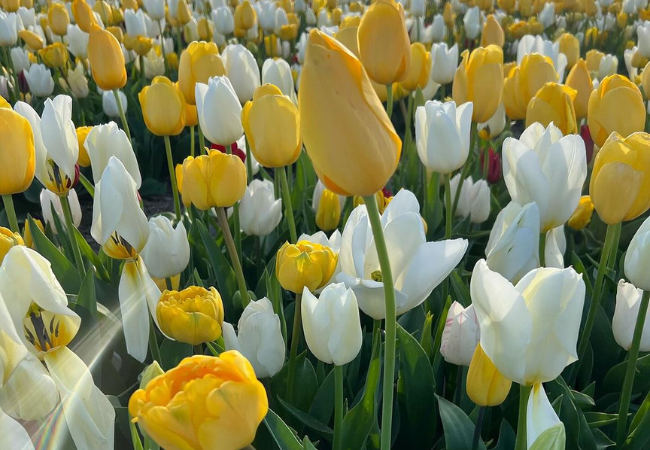Discover the beauty and care of Tulips: Learn about their history, varieties, planting tips and symbolic meaning. Perfect for gardeners and flower enthusiasts looking to add these colorful blooms to their spring gardens.
Tulips are some of the most popular flowers in the world. Their bright colors and simple shape make them a favorite in many gardens. In this article, we’ll talk about tulips, how to grow them and why so many people love them.
Here’s an information chart for Tulips:
| Category | Information |
|---|---|
| Botanical Name | Tulipa spp. |
| Common Name | Tulip |
| Plant Type | Bulbous perennial |
| Hardiness Zone | Zones 3-8, depending on species |
| Sun Exposure | Full sun |
| Soil Type | Well-draining, fertile |
| Watering | Moderate |
| Growth Habit | Upright, clumping |
| Height/Spread | 6 inches to 2 feet tall, spreads 4-6 inches |
| Special Features | Colorful cup-shaped flowers, blooms in spring, deer resistant, variety of colors and forms |
What are Tulips?

Tulips are flowers that usually bloom in spring. They come from the same family as lilies. Tulips have a long history and were once so valuable in Holland that they caused the first economic bubble, known as “Tulip Mania.”
Key Features
- Cup-shaped flowers with six petals
- Many colors available
- Grow from bulbs
- Usually bloom in spring
Growing Tulips
If you want to grow tulips in your garden, here’s what you need to know:
Planting
- Best time to plant: Fall, about 6-8 weeks before the ground freezes
- Soil: Well-draining soil
- Sunlight: Full sun to partial shade
Care
- Watering: Water well after planting, then only when soil is dry
- Fertilizer: Use bulb fertilizer in fall and early spring
- After blooming: Let leaves die back naturally to feed the bulb
Pests and Problems
- Watch out for: Deer, rabbits and squirrels
- Diseases: Tulip fire, bulb rot
For more detailed planting instructions, check out this guide from Cornell University.
Popular Tulip Types
Single Early Tulips
- Bloom early in spring
- Classic cup shape
Darwin Hybrid Tulips
- Large flowers
- Strong stems good for cutting
Parrot Tulips
- Ruffled, feathery petals
- Unique, exotic look
Species Tulips
- Smaller, wild-looking flowers
- Good for rock gardens
Learn more about tulip varieties from the United States National Arboretum.
Using Tulips in Your Garden
Tulips are great for:
- Spring flower beds
- Container gardening
- Cutting gardens for bouquets
- Naturalizing in lawns
They look nice with other spring flowers like:
- Daffodils
- Hyacinths
- Pansies
For ideas on combining spring flowers, visit the National Garden Bureau.
Caring for Tulips
After Blooming
- Cut off flower stems but leave leaves
- Let leaves yellow and die naturally
- Dig up bulbs in warm climates and store for next year
Dividing Bulbs
- Every 3-4 years, dig up bulbs and separate
- Replant larger bulbs, discard smaller ones
Winter Care
- In cold areas, add mulch after ground freezes
- Remove mulch in spring when shoots appear
The University of Minnesota Extension offers more tips on tulip care.
Tulip Meanings and Uses
- Red tulips often mean “true love”
- Yellow can mean “cheerful thoughts”
- Purple represents royalty
- Used in many floral arrangements
- National flower of the Netherlands and Turkey
Tulips are beautiful, easy-to-grow flowers that can bring color to any spring garden. Whether you plant them in beds, pots or scatter them through your lawn, tulips are sure to brighten up your space. With so many colors and types to choose from, there’s a tulip for everyone.
Remember, gardening is about enjoying nature and learning as you go. Don’t be afraid to try different tulip varieties and see what works best in your garden. Happy planting!
For more gardening tips and plant care guides, visit usagardenhub.com.






4 Comments on “Tulips : Colorful Stars of Spring”